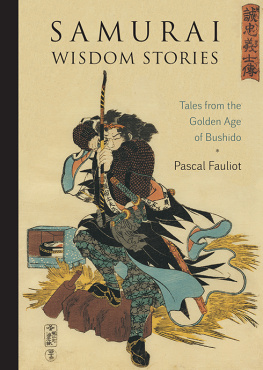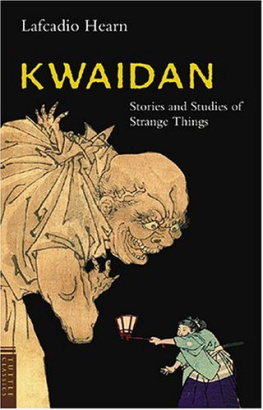THE KWAIDAN OF THE LADY OF TAMIYA
Kwaidan are what Lafcadio Hearn called stories and studies of strange things eerie tales which convey the enduring mystery of traditional Japanese culture and the world of the samurai. In this volume, de Benne ville's rendition of the Yotsuya Kwaidan of Shunkintei Ryuo paints a picture of life in the capital city of Edo among the samurai of the highest class, jostling for power at the court of the Shogun. At the heart of the story is the Lady of Tamiya, a daughter of the samurai who is sold by her brutal husband into the floating world of the brothels, from which she escapes only in death. Thereafter, the Lady is avenged as misfortune relentlessly overtakes all who betrayed her, and she is still remembered today in a Tokyo shrine popular with women who seek her protection. More than any history, kwaidan reveal the inner morality of the samurai code.
The late JAMES S. DE BENNEVILLE, American author, translator and scholar, and long-time resident of Japan is well known for his superb renditions of Japan's great historic literary classics. Among his works is Tales of the Samurai, also published by Kegan Paul.

THE O'IWA OF THE TAMIYA INARI JINJA OF ECHIZENBORI, TOKYO
THE KWAIDAN OF THE LADY OF TAMIYA
SAMURAI TALES OF THE TOKUGAWA
JAMES S. DE BENNEVILLE
First published in 2001 by
Kegan Paul International
This edition first published in 2010 by
Routledge
2 Park Square, Milton Park, Abingdon, Oxon, OX14 4RN
Simultaneously published in the USA and Canada
by Routledge
711 Third Avenue, New York, NY 10017
Routledge is an imprint of the Taylor & Francis Group, an informa business
Kegan Paul, 2001
All rights reserved. No part of this book may be reprinted or reproduced or utilised in any form or by any electronic, mechanical, or other means, now known or hereafter invented, including photocopying and recording, or in any information storage or retrieval system, without permission in writing from the publishers.
British Library Cataloguing in Publication Data
A catalogue record for this book is available from the British Library
ISBN 10: 0-7103-0700-4 (hbk)
ISBN 13: 978-0-7103-0700-2 (hbk)
Publisher's Note
The publisher has gone to great lengths to ensure the quality of this reprint but points out that some imperfections in the original copies may be apparent. The publisher has made every effort to contact original copyright holders and would welcome correspondence from those they have been unable to trace.
PREFACE
TALES of the Tokugawa can well be introduced by two wonder-stories of Nippon. One of these, the Yotsuya Kwaidan, is presented in the present volume, not so much because of the incidents involved and the peculiar relation to a phase of Nipponese mentality, as from the fact that it contains all the machinery of the Nipponese ghost story. From this point of view the reading of one of these tales disposes of a whole class of the native literature. Difference of detail is found. But unless the tale carries some particular interest, as of curious illustration of customs or historythe excuse for a second presentationa long course of such reading becomes more than monotonous. It is unprofitable. Curiously enough, it can be said that most Nipponese ghost stories are true. When a sword is found enshrined, itself the malevolent influenceas is the Muramasa blade of the Hamamatsu Suwa Jinja, the subject of the Komatsu Onryu of Matsubayashi Hakuchiand with such tradition attached to it, it is difficult to deny a basis of fact attaching to the tradition. The ghost story becomes merely an elaboration of an event that powerfully impressed the men of the day and place. Moreover this naturalistic element can be detected in the stories themselves. Nipponese writers of to-day explain most of them by the word shinkeinerves; the working of a guilty conscience moulding succeeding events, and interpreting the results to the subsequent disaster involved. The explanation is somewhat at variance with the native Shint doctrine of the moral perfection of the Nipponese, and its maximfollow the dictates of one's heart ; but that is not our present concern.
Their theory, however, finds powerful support in the nature of the Nipponese ghost. The Buddhist ghost does not remain on earth. It has its travels and penalties to go through in the nether world, or its residence in Paradise, before it begins a new lifesomewhere. The Shint ghost, in the vagueness of Shint theology, does remain on earth. If of enough importance it is enshrined, and rarely goes abroad, except when carried in procession at the time of the temple festival. Otherwise it finds its home in the miniature shrine of the kami-dana or god-shelf. There is a curious confusion of Nipponese thought on this subject; at least among the mass of laity. At the Bon-Matsuri the dead revisit the scene of their earthly sojourn for the space of three days ; and yet the worship of the ihai, or mortuary tablets, the food offerings with ringing of the bell to call the attention of the resident Spirit is a daily rite at the household Buddhist shrine (Butsu-dan). When, therefore, the ghost does not conform to these well-regulated habits, it is because it is an unhappy ghost. It is then the O'Bak or Bakmono, the haunting ghost. Either it has become an unworshipped spirit, or, owing to some atrocious injury in life, it stays to wander the earth, and to secure vengeance on the living perpetrator. In most cases this is effected by the grudge felt or spoken at the last moment of life. The mind, concentrated in its hate and malice at this final crisis, secures to the Spirit a continued and unhappy sojourn among the living, until the vengeance be secured, the grudge satisfied, and the Spirit pacified. There are other unhappy conditions of this revisiting of life's scenes ; as when the dead mother returns to nurse her infant, or the dead mistress to console a lover. In the latter case, at least, the expressed affection has a malignant effect, perhaps purposeas in the Btan Dr of Sanytei Ench, a writer most careful in observing all the niceties called for by the subject.
In the Nipponese ghost story the vengeful power of the ghost acts through entirely natural means. The characters involved suffer through their own delusions aroused by conscience. In the old days, and among the common people in Nippon to-day, the supernatural was and is believed in, with but few exceptions. Such stories still are held to be fact, albeit the explanation is modern. Hence it can be said that the Yotsuya Kwaidan is a true story. O'Iwa, the Lady of Tamiya, really did exist in the Genroku and Hrei periods (16881710); just ante-dating the reforming rule of the eighth Tokugawa Shgun, Yoshimune K. Victim of an atrocious plot of her husband and others, she committed suicide with the vow to visit her rage upon all engaged in the conspiracy. The shrine of the O'Iwa Inari (Fox-witched O'Iwa) in Yotsuya was early erected (1717) to propitiate her wrathful ghost; and the shrines of Nippon, to the shabbiest and meanest, have their definite record. On the register the name of the husband appears as Ibei; probably correct. as Mr. Momogawa tells us. With him the name of Imon is retained in the present story. Imon is the classic example of the wicked and brutal husband, on the stage and in the Gidayu recitation of Nippon. There was but little reason to revert to the record. The shrine always prospered. It appears on the maps of the district as late as Ansei fourth year (1857); and the writer has had described to him by a friend a visit to this shrine some twenty years ago. The lady in question referred to it rather vaguely as beyond Samegafuchi:














